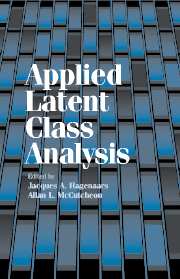Book contents
- Frontmatter
- Contents
- Contributors
- Preface
- INTRODUCTION
- CLASSIFICATION AND MEASUREMENT
- 3 Latent Class Cluster Analysis
- 4 Some Examples of Latent Budget Analysis and Its Extensions
- 5 Ordering the Classes
- 6 Comparison and Choice: Analyzing Discrete Preference Data by Latent Class Scaling Models
- 7 Three-Parameter Linear Logistic Latent Class Analysis
- CAUSAL ANALYSIS AND DYNAMIC MODELS
- UNOBSERVED HETEROGENEITY AND NONRESPONSE
- Appendix A: Notational Conventions
- Appendix B: Further Readings
- Appendix C: Selected Software; Webpage
- Index
5 - Ordering the Classes
Published online by Cambridge University Press: 31 July 2009
- Frontmatter
- Contents
- Contributors
- Preface
- INTRODUCTION
- CLASSIFICATION AND MEASUREMENT
- 3 Latent Class Cluster Analysis
- 4 Some Examples of Latent Budget Analysis and Its Extensions
- 5 Ordering the Classes
- 6 Comparison and Choice: Analyzing Discrete Preference Data by Latent Class Scaling Models
- 7 Three-Parameter Linear Logistic Latent Class Analysis
- CAUSAL ANALYSIS AND DYNAMIC MODELS
- UNOBSERVED HETEROGENEITY AND NONRESPONSE
- Appendix A: Notational Conventions
- Appendix B: Further Readings
- Appendix C: Selected Software; Webpage
- Index
Summary
INTRODUCTION
The Problem of Ordering the Classes in Latent Class Analysis
Latent class analysis was conceived by Lazarsfeld (1950a, 1950b, 1954) as a method for analyzing the association among manifest qualitative variables in terms of an unobserved nominal variable whose values represent different subpopulations. The latent class model assumes that the heterogeneous population from which the respondents were sampled can be partitioned in a restricted number of homogeneous subpopulations: the latent classes. Individual respondents belong to one of these classes, and respondents belonging to the same class share with each other the same set of response probabilities for the manifest variables. Furthermore, within each latent class the responses to different manifest variables are supposed to be stochastically independent. This assumption of local indepedence, as it is called, implies that the classes in the latent class model can be considered to be the values of a nominal latent variable in such a way that if one conditions on the value of the latent variable, the association between the manifest variables disappears completely. The association among the manifest variables is then completely explained by their relationships with the latent variable.
In this basic formulation of the latent class model, nothing impels the classes to be ordered along some continuum because the set of latent classes only represents a partition of the original population into disjoint subpopulations. The latent variable, whose levels correspond to the classes, is clearly a nominal variable.
- Type
- Chapter
- Information
- Applied Latent Class Analysis , pp. 137 - 162Publisher: Cambridge University PressPrint publication year: 2002
- 15
- Cited by



